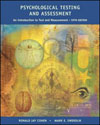Choose the best answer to each question based on material presented in Psychological Testing and Assessment, 5th Edition by Ronald Cohen and Mark Swerdlik.
These questions only sample material from the chapter; there is much more to know than sampled here.
 |
1 |  | 
Regarding intelligence, |
|  | A) | there is no widely accepted definition of it. |
|  | B) | there is one widely accepted definition of it. |
|  | C) | there are two widely accepted definitions of it. |
|  | D) | much like beauty, it can be seen only by the beholder. |
 |
 |
2 |  | 
In a study conducted by Sternberg and his associates, nonpsychologists associated all of the following with intelligence EXCEPT |
|  | A) | logical reasoning. |
|  | B) | motivated in chosen pursuits. |
|  | C) | reads with high comprehension. |
|  | D) | reads widely. |
 |
 |
3 |  | 
Research with elementary school students suggests that they might most readily equate which with intelligence? |
|  | A) | Keeping an open mind. |
|  | B) | Studying hard. |
|  | C) | Being able to solve problems. |
|  | D) | Acting nice. |
 |
 |
4 |  | 
In 1921, 17 of the country's leading psychologists participated in a symposium on the nature of intelligence and |
|  | A) | a widely accepted definition of intelligence was the result. |
|  | B) | the view that intelligence is what intelligence tests measure resulted. |
|  | C) | no two of the participants agreed on a definition. |
|  | D) | most evidence presented supported Galton's views. |
 |
 |
5 |  | 
Which person is best associated with the view that nonintellective factors such as personality, persistence, and goal awareness must be considered when measuring intelligence? |
|  | A) | Alfred Binet. |
|  | B) | David Wechsler. |
|  | C) | Sir Francis Galton. |
|  | D) | Sir Rudy Guilliani. |
 |
 |
6 |  | 
It's in this Piagetian stage that the child's understanding of concepts is based largely on what is seen and animistic thinking is in evidence. It is the |
|  | A) | sensorimotor period. |
|  | B) | preoperation period. |
|  | C) | concrete operations period. |
|  | D) | formal operations period. |
 |
 |
7 |  | 
In the two-factor theory of intelligence, there is a general intelligence factor denoted by g, and |
|  | A) | specific components of intelligence denoted by s. |
|  | B) | error components of measurements denoted by e. |
|  | C) | all of the above. |
|  | D) | none of the above. |
 |
 |
8 |  | 
The view that intelligence is genetically transmitted was expressed in books such as |
|  | A) | English Men of Science. |
|  | B) | The Kallikak Family. |
|  | C) | Hereditary Genius. |
|  | D) | all of the above. |
 |
 |
9 |  | 
The roots of current books on "emotional intelligence" can be found most readily in the writings of |
|  | A) | Thurstone. |
|  | B) | Gardner. |
|  | C) | McGrew. |
|  | D) | Spearman. |
 |
 |
10 |  | 
Which type of intelligence is thought to be relatively culture-free in nature? |
|  | A) | Interpersonal intelligence. |
|  | B) | Fluid intelligence. |
|  | C) | Crystallized intelligence. |
|  | D) | Family intelligence. |
 |
 |
11 |  | 
In Carroll's three-stratum theory of cognitive abilities |
|  | A) | the top level or stratum is g or general intelligence. |
|  | B) | the second stratum is composed of 12 processes. |
|  | C) | the third stratum is composed of over 100 abilities. |
|  | D) | all of the above. |
 |
 |
12 |  | 
A key difference between Cattell-Horn model of cognitive abilities and the Carroll model has to do with |
|  | A) | the abilities conceived of as fluid or crystallized. |
|  | B) | how g or general intelligence is conceptualized. |
|  | C) | the speed with which various processes occur. |
|  | D) | how Binet's ideas are integrated into the theory. |
 |
 |
13 |  | 
Who is best associated with the study of intelligence in terms of the ways in which information is processed? |
|  | A) | E. L. Thorndike. |
|  | B) | John Carroll. |
|  | C) | Aleksandr Luria. |
|  | D) | Pavel Bure. |
 |
 |
14 |  | 
The doctrine of predeterminism holds that |
|  | A) | no amount of learning can enhance what has been genetically encoded. |
|  | B) | walking, swimming, and other motor activities can be learned later in life. |
|  | C) | all living organisms are preformed at birth. |
|  | D) | all living organisms have their destiny set at birth. |
 |
 |
15 |  | 
The "Flynn effect" is a reference to the phenomenon of |
|  | A) | "inflation" of measured intelligence on tests. |
|  | B) | "recession" in the ceiling effect for giftedness. |
|  | C) | gender differences in measured intelligence. |
|  | D) | culture loading of tests in terms of language. |
 |



 2002 McGraw-Hill Higher Education
2002 McGraw-Hill Higher Education